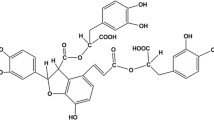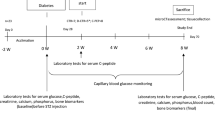Abstract
The purpose of this study was to analyze the impact of vanadium absorbed by Coprinus comatus (VACC) on fracture healing in streptozotocin-diabetic rats. Forty-five male Wistar rats used were divided into three groups: normal rats (control), diabetic rats, and diabetic rats treated with VACC. A standardized fracture-healing model with a stable plate fixation was established for the rat femoral fracture. After a 4-week stable fixation, callus quality was assessed by microcomputerized tomography and histological and biomechanical examinations. In addition, bone samples were obtained to evaluate the content of mineral substances in bones. Compared with the diabetic group, vanadium treatment significantly increased bone mineral content and biomechanical strength and improved microstructural properties of the callus. The ultimate load was increased by 29.1 % (P < 0.05), and the total bone volume of callus enhanced by 11.2 % (P < 0.05) at 4 weeks post fracture. Vanadium also promoted callus bone formation, which caused a 35.5 % increase in the total area of callus. However, VACC did not accelerate the fracture repair process in histological analysis. In conclusion, the current study suggests that systemic treatment with vanadium could promote fracture healing in streptozotocin-diabetic rats.




Similar content being viewed by others
References
Funk JR, Hale JE, Carmines D et al (2000) Biomechanical evaluation of early fracture healing in normal and diabetic rats. J Orthop Res 18:126–132
Herbsman H, Powers JC, Hirschnian A, Shaftan GW (1968) Retardation of fracture healing in experimental diabetes. J Surg Res 8:424–431
Loder RT (1988) The influence of diabetes mellitus on the healing of closed fractures. Clin Orthop Relat Res 232:210–216
Macey LR, Kana SM, Jingushi S et al (1989) Defects of early fracture healing in experimental diabetes. J Bone Joint Surg Am 71:722–733
Cozen L (1972) Does diabetes delay fracture healing? Clin Orthop 82:134–140
Einhorn TA, Boskey AL, Gundberg CM, Vigorita VJ, Devlin VJ, Beyer MM (1988) The mineral and mechanical properties of bone in chronic experimental diabetes. J Orthop Res 6:317–323
Spanheimer RG (1992) Correlation between decreased collagen production in diabetic animals and in cells exposed to diabetic serum: response to insulin. Matrix 12:101–107
Topping RE, Bolander ME, Balian G (1994) Type X collagen in fracture callus and the effects of experimental diabetes. Clin Orthop 2:220–228
Thrailkill KM, Lumpkin CK Jr, Bunn RC et al (2005) Is insulin an anabolic agent in bone? Dissecting the diabetic bone for clues. Am J Physiol Endocrinol Metab 289:E735–E745
Beam HA, Parsons JR, Lin SS (2002) The effects of blood glucose control upon fracture healing in the BB Wistar rat with diabetes mellitus. J Orthop Res 20:1210–1216
Hough S, Avioli LV, Bergfeld MA, Fallon MD, Slatopolsky E, Teitelbaum SL (1981) Correction of abnormal bone and mineral metabolism in chronic streptozotocin-induced diabetes mellitus in the rat by insulin therapy. Endocrinology 108:2228–2234
Stuck WG (1932) The effect of insulin on the healing of experimental fractures in the rabbit. J Bone Joint Surg 14:109
Stunkle G, Wray JB (1965) The effect of exogenous insulin on fracture healing in the intact rat. Clin Orthop Relat Res 40:30–34
Paglia D, Wey A, Vaidya S et al (2011) The angiogenic effects of local ultralente insulin on periosteal bone formation. Orthopaedic Research Society, Long Beach
Domingo JL (2002) Vanadium and tungsten derivatives as antidiabetic agents: a review of their toxic effects. Biol Trace Elem Res 88:97–112
Scior T, Guevara-García A, Bernard P et al (2005) Are vanadium compounds drugable? Structures and effects of antidiabetic vanadium compounds: a critical review. Mini Rev Med Chem 5:995–1008
Zhaoji M, Qin F (2009) Comparison of hypoglycemic activity and toxicity of vanadium (IV) and vanadium (V) absorbed in fermented mushroom of Coprinus comatus. Biol Trace Elem Res 132(1–3):278–284
Pei Y, Fu Q (2011) The effects of vanadium (V) absorbed by Coprinus comatus on bone in streptozotocin-induced diabetic rats. Biol Trace Elem Res 142:748–759
Han C, Yuan J, Wang Y (2006) Hypoglycemic activity of fermented mushroom of Coprinus comatus rich in vanadium. J Trace Elem Med Biol 20(3):191–196
Wang JW, Xu SW, Yang DS, Lv RK (2007) Locally applied simvastatin promotes fracture healing in ovariectomized rat. Osteoporos Int 18:1641–1650
Rundle CH, Wang X, Wergedal JE, Subburaman Mohan K-H, Lau W (2008) Fracture healing in mice deficient in plasminogen activator inhibitor-1. Calcif Tissue Int 83:276–284
Bonnarens F, Einhorn TA (1984) Production of a standard closed fracture in laboratory animal bone. J Orthop Res 2:97–101
Holstein JH, Matthys R, Histing T, Becker SC, Fiedler M, Garcia P, Meier C, Pohlemann T, Menger MD (2009) Development of a stable closed femoral fracture model in mice. J Surg Res 153:71–75
Claes L, Schmalenbach J, Herrmann M, lkü IÖ, Garcia P, Histing T, Obeid R, Schorr H, Herrmann W, Pohlemann T, Menger MD, Holstein JH (2009) Hyperhomocysteinemia is associated with impaired fracture healing in mice. Calcif Tissue Int 85:17–21
Habermann B, Kafchitsas K, Olender G, Augat P, Kurth A (2010) Strontium ranelate enhances callus strength more than PTH 1–34 in an osteoporotic rat model of fracture healing. Calcif Tissue Int 86:82–89
Gerstenfeld LC, Sacks DJ, Pelis M, Mason ZD, Graves DT, Barrero M, Ominsky MS, Kostenuik PJ, Morgan EF, Einhorn TA (2009) Comparison of effects of the bisphosphonate alendronate versus the RANKL inhibitor denosumab on murine fracture healing. J Bone Miner Res 24:196–208
Kakar S, Einhorn TA, Vora S, Miara LJ, Hon G, Wigner NA, Toben D, Jacobsen KA, Al-Sebaei MO, Song M, Trackman PC, Morgan EF, Gerstenfeld LC, Barnes GL (2007) Enhanced chondrogenesis and Wnt signaling in PTH-treated fractures. J Bone Miner Res 22:1903–1912
Bancroft JD (2002) Enzyme histochemistry and its diagnostic applications. In: Bancroft JD, Gamble M (eds) Theory and practice of histological techniques. Harcourt, New York, pp 593–620
Goto A, Tsukamoto I (2003) Increase in tartrate-resistant acid phosphatase of bone at the early stage of ascorbic acid deficiency in the ascorbate-requiring Osteogenic Disorder Shionogi (ODS) rat. Calcif Tissue Int 73:180–185
Gandhi A, Doumas C, O'Connor JP, Parsons JR, Lin SS (2006) The effects of local platelet rich plasma delivery on diabetic fracture healing. Bone 38:540–546
Meinel L, Zoidis E, Zapf J, Hassa P, Hottiger MO, Auer JA, Schneider R, Gander B, Luginbuehl V, Bettschart-Wolfisberger R, Illi OE, Merkle HP, von Rechenberg B (2003) Localized insulin-like growth factor I delivery to enhance new bone formation. Bone 33:660–672
Tolman EL, Barris E, Burns M, Pansini A, Partridge R (1979) Effects of vanadium on glucose metabolism in vitro. Life Sci 25:1159–1164
Shechter Y, Karlish SJ (1980) Insulin-like stimulation of glucose oxidation in rat adipocytes by vanadyl (IV) ions. Nature 284:556–558
Dubyak GR, Kleinzeller A (1980) The insulin-mimetic effects of vanadate in isolated rat adipocytes. Dissociation from effects of vanadate as a (Na+−K+) ATPase inhibitor. J Biol Chem 255:5306–5312
Degani H, Gochin M, Karlish SJ, Shechter Y (1981) Electron paramagnetic resonance studies and insulin-like effects of vanadium in rat adipocytes. Biochemistry 20:5795–5799
Green A (1986) The insulin-like effect of sodium vanadate on adipocyte glucose transport is mediated at a post-insulin-receptor level. Biochem J 238:663–669
Tamura S, Brown TA, Whipple JH, Fujita-Yamaguchi Y, Dubler RE, Cheng K et al (1984) A novel mechanism for the insulin-like effect of vanadate on glycogen synthase in rat adipocytes. J Biol Chem 259:6650–6658
Clark AS, Fagan JM, Mitch WE (1985) Selectivity of the insulin-like actions of vanadate on glucose and protein metabolism in skeletal muscle. Biochem J 232:273–276
Strout HV, Vicario PP, Saperstein R, Slater EE (1989) The insulin-mimetic effect of vanadate is not correlated with insulin receptor tyrosine kinase activity nor phosphorylation in mouse diaphragm in vivo. Endocrinology 124:1918–1924
Fantus IG, Kadota S, Deragon G, Foster B, Posner BI (1989) Pervanadate [peroxide (s) of vanadate] mimics insulin action in rat adipocytes via activation of the insulin receptor tyrosine kinase. Biochemistry 28:8864–8871
Shisheva A, Shechter Y (1992) Quercetin selectively inhibits insulin receptor function in vitro and the bioresponses of insulin and insulinomimetic agents in rat adipocytes. Biochemistry 31:8059–8063
Pei Y, Fu Q (2010) Yeast-incorporated gallium promotes fracture healing by increasing callus bony area and improving trabecular microstructure on ovariectomized osteopenic rats. Biol Trace Elem Res 141(1–3):207–215
Facchini DM, Yuen VG, Battell ML, McNeill JH, Grynpas MD (2006) The effects of vanadium treatment on bone in diabetic and non-diabetic rats. Bone 38:368–377
Schmidmaier G, Wildemann B, Melis B, Krummrey G, Einhorn A, Haas N, Raschke M (2004) Development and characterization of a standard closed tibial fracture model in the rat. Eur J Trauma 30:35–42
Hadjiargyrou M, Lambardo F, Zhao S, Ahrens W, Joo J, Ahn H, Jurman M, White DW, Rubin CT (2002) Transcriptional profiling of bone regeneration: insight into the molecular complexity of wound repair. J Biol Chem 277:30177–30182
Pothuaud L, Rietbergen BV, Mosekilde L et al (2002) Combination of topological parameters and bone volume fraction better predicts the mechanical properties of trabecular bone. Bone 35:1091–1099
Link TM (2001) Changes in trabecular bone structure assessed by high-resolution MRI in patients after transplantation. Adv Exp Med Biol 496:31–36
Link T, Majumdar S, Augat P, Lin J, Newitt D, Lu Y, Lane N, Genant H (1998) In vivo high resolution MRI of the calcaneus: differences in trabecular structure in osteoporosis patients. J Bone Miner Res 13:1175–1182
Link T, Saborowski S, Kisters K, Kempkes M, Kosch M, Newitt D, Lu Y, Waldt S, Majumdar S (2002) Changes in calcaneal trabecular bone structure assessed with high resolution MRI in patients with kidney transplantation. Osteoporos Int 2002:119–129
Shyng YC, Devlin H, Sloan P (2001) The effect of streptozotocin-induced experimental diabetes mellitus on calvarial defect healing and bone turnover in the rat. Int J Oral Maxillofac Surg 30:70–74
Shires R, Teitelbaum SL, Bergfeld MA, Fallen MD, Slatopolsky E et al (1981) The effect of streptozotocin-induced chronic diabetes mellitus on bone mineral homeostasis in the rat. J Lab Clin Med 97:231–240
Bain S, Ramamurthy NS, Impeduglia T, Scolman S, Golub LM (1997) Tetracycline prevents cancellous bone loss and maintains near-normal rates of bone formation in streptozotocin diabetic rats. Bone 21:147–153
Barrio DA, Braziunas MD, Etcheverry SB, Cortizo AM (1997) Maltol complexes of vanadium (IV) and (V) regulate in vitro alkaline phosphatase activity and osteoblast-like cell growth. J Trace Elem Med Biol 11:110–115
Etcheverry SB, Crans DC, Keramidas AD, Cortizo AM (1997) Insulin-mimetic action of vanadium compounds on osteoblast-like cells in culture. Arch Biochem Biophys 338:7–14
Thomas DM, Hards DK, Rogers SD, Ng KW, Best JD (1996) Insulin receptor expression in bone. J Bone Miner Res 11:1312–1320
Cornish J, Callon KE, Reid IR (1996) Insulin increases histomorphometric indices of bone formation in vivo. Calcif Tissue Int 59:492–495
Acknowledgments
This study was supported by the National Natural Science Foundation of China. Fund number: 81070688/H0726. We would like to thank Central Laboratory, Shengjing Hospital of China Medical University for providing the necessary facilities and equipments to carry out this research.
Author information
Authors and Affiliations
Corresponding author
Rights and permissions
About this article
Cite this article
Wang, G., Wang, J., Fu, Y. et al. Systemic Treatment with Vanadium Absorbed by Coprinus comatus Promotes Femoral Fracture Healing in Streptozotocin-Diabetic Rats. Biol Trace Elem Res 151, 424–433 (2013). https://doi.org/10.1007/s12011-012-9584-5
Received:
Accepted:
Published:
Issue Date:
DOI: https://doi.org/10.1007/s12011-012-9584-5




